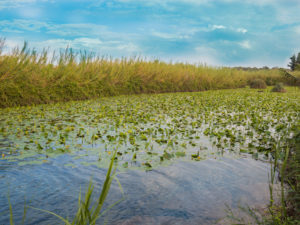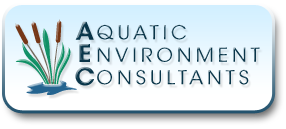
The presence of algae or other invasive plant species can quickly ruin your enjoyment of your lake or pond. Invasive plant growth also indicates a fundamental lack of balance in your pond’s ecosystem. For these reasons, it’s important to quickly and conclusively take care of unwanted plants when they first occur.
At Aquatic Environment Consultants (AEC), we have more than 30 years of experience with invasive lake species management. Instead of providing a quick, unreliable fix, we offer solutions that get to the bottom of the issue and restore health and balance to your lake.
Learn more about invasive plant species, our control process, and the areas we serve below. Then, give us a call at 717-264-9778 to learn how we can keep your lake or pond healthy and beautiful with ongoing invasive aquatic plant management.
What Are Invasive Aquatic Plants?
If you own a lake or pond as part of a homeowners’ association, golf course, or similar property, you may have noticed several types of aquatic plants growing in and along your waterway. A healthy number of these plants is a natural and beneficial part of maintaining your pond. Aquatic plants provide habitats for your fish population, food for nearby birds and amphibians, and oxygenation for your fish’s longevity.
However, non-native plant populations can pose significant problems. As they spread, they can disrupt the ecology, threaten native species and limit swimmers’ and boaters’ use of the area. Excess weeds and plants can even create unsafe or unhealthy swimming conditions.
Invasive Aquatic Plant Control Methods
An area may be introduced to invasive aquatic plants through overloading of nutrients like nitrates and phosphates or by human means. The species can then rapidly dominate the surrounding area and prove more difficult to control. Early detection and management are essential to maintaining the health of your pond or lake.
At AEC, we offer management options that effectively control these populations and limit the risk of new invasive species growth. Our process includes:
- Identifying the invasive aquatic plant species threatening your pond or lake
- Distinguishing what plant species and amounts of these plants are needed to sustain your fish and wildlife populations
- Deciding how to proceed based on your specific site and goals
- Developing a long-term management plan that combines treatment strategies as needed to eliminate the invasive species
- Educating you, your employees, and your guests on ways to protect your water from further plant invasion
- Regularly assessing the results of our treatment plan and re-directing our ongoing management strategies as needed
Our experts will strive to meet and exceed your expectations by personalizing our treatment to your pond or lake’s specific needs. Through ongoing maintenance, we’ll be here to support you every step of the way in your invasive aquatic pond species management.
Types of Common Invasive Aquatic Plants
Any freshwater plant exhibiting excessive and unwanted growth can be considered invasive, particularly if that growth is affecting the health of other species in your lake or pond. In the Midwest and mid-Atlantic regions, some of the most common invasive plants in lake and ponds include:
- Purple loosestrife — Purple loosestrife is easily identifiable thanks to its bright purple flowers, which grow on long spikes located on the top of their stems. Once it takes root in a lake or pond, purple loosestrife spreads quickly, crowding out other species and destroying the natural habitat of birds, fish and other animals.
- Brazilian Elodea — Brazilian elodea grows underwater and can be differentiated from harmless water plants by its long, wide leaves. The plant is often used in home aquariums, and it spreads to freshwater bodies when people carelessly discard the contents of an old tank. Once it has taken root in a pond or lake, Brazilian elodea grows quickly and aggressively. This causes increased sedimentation, impeding water flow, reduced oxygen, and crowding of other plants.
- Hydrilla — Hydrilla is listed on the federal noxious weed list, and it’s one of the more common invasive plants in lakes and ponds in the Midwest and mid-Atlantic regions. Hydrilla grows in thick mats and can rise to the surface of a lake or pond when its growth is unchecked. It is identifiable by its small, pointed leaves and long, branched stems. These can grow at a rate of up to one inch per day. If this growth isn’t controlled, it can alter the chemical composition of your lake or pond, putting native plants and animals at risk.
Invasive species can be either submerged underwater, floating on the surface of your pond, or rooted in shallow and emerging from the water. Each type has different implications for the health of your pond’s ecosystem, necessitating different remediation strategies. At AEC, we’ll use our expertise to help you develop a plan for combating unwanted plant growth.
Invasive Species Treatment Strategies
When we recommend invasive species treatment strategies, some common suggestions include:
- Mechanical — Rakes, seines, harvesters, and other tools can clear away invasive plant growth quickly. If you primarily use your lake or pond for swimming or boating, this is an effective way to restore its natural beauty. You and your guests will be able to use the water immediately after a mechanical treatment.
- Biological — A lake or pond must be a functional ecosystem. Often, plants that crowd other vegetation can be controlled by the introduction of natural predators, including certain types of fish and insects. Biological controls are perhaps one of the most environmentally friendly treatment options and can effectively target only the specific species you want to eliminate.
- Physical — Altering the physical properties of your lake or pond can be useful in promoting healthy water chemistry, which limits the damage invasive species can do. Adding an aerator or fountain is an easy, long-term solution to some of the water quality issues that promote the growth of algae and other invasive species. Other physical solutions include dredging, shading and adding a benthic barrier. Like mechanical treatments, physical strategies will allow you to use the area immediately after treatment.
- Herbicides and Algaecides — The use of commercial products for plant control in a lake or pond is a very effective management strategy. When this is required, it’s important to have the procedure done by a professional who can minimize its impact on other plants and animals. Material treatments like these have the benefit of low initial costs and fast action time.
An informed approach to invasive species management in a lake or pond may combine some or all of these methods. For example, the use of mechanical or material controls can be an effective short-term intervention that clears away nuisance weeds. When used properly, the application of materials such as systemic herbicides can lead to the eradication of invasive plant species. AEC’s experts can combine treatment options to form a solution uniquely designed to treat the root cause of your invasive plant species.
States We Serve With Our Invasive Aquatic Plant Control Service
At AEC, our professional team spans across the country’s Eastern and Midwestern states, offering invasive aquatic pond species management to the places that need it most. Our service area includes:
Contact AEC for Assistance With Your Invasive Species Problem
AEC provides consulting and other services related to the management of invasive plant species in your lake and pond. We begin with an initial assessment of water quality and vegetation, and we develop a comprehensive, long-term plan for intervention and management.
Don’t let excessive plant growth limit your ability to enjoy a clean and healthy lake or pond. We serve a wide range of clients, including homeowners’ associations, golf courses and more. Contact our office to arrange a meeting with one of our experts today.

